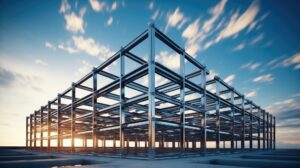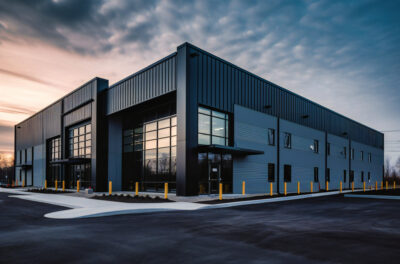The field of construction is continually evolving, with materials and methods adapting to meet diverse needs. In this context, steel buildings stand out for their versatility in commercial construction. Renowned for their strength and durability, they’re a practical choice for many types of building projects.
When selecting materials for your upcoming project, consider the advantages of steel. It’s used in everything from towering skyscrapers to expansive warehouses, offering flexibility in design and utility. Understanding the role of this resilient metal in construction can provide valuable insights, especially when planning projects that demand both reliability and adaptability.
Design Flexibility With Steel
Steel extends beyond structural integrity in construction, offering architects and builders unparalleled design flexibility. Its ability to support vast, open spaces with minimal support pillars enables a variety of architectural styles and functional layouts. This versatility is evident in both large-scale structures and smaller, detailed projects, where precision and adaptability are crucial.
This material’s compatibility with different construction methods and materials enhances its utility. It can be shaped to fit various design concepts, blending modern with traditional aesthetics. Steel’s adaptability is essential for projects where both appearance and functionality are key priorities.
In essence, steel doesn’t just fulfill structural needs; it expands the horizon of architectural possibilities. From elegant facades to innovative silhouettes and efficient modular designs, steel embodies the creative potential and versatility of contemporary construction materials.

Steel In Diverse Construction Applications
Steel’s versatility in construction is most prominently showcased in its application across a variety of building types. From towering skyscrapers to expansive commercial complexes, this robust material plays a vital role in shaping the modern built environment.
- Skyscrapers And High-Rises: Steel is favored for its strength and lightweight nature, making it ideal for tall structures where stability and resistance to wind and seismic forces are critical.
- Commercial Warehouses And Industrial Buildings: Ideal for large, open spaces without internal columns, this dependable material provides flexibility in space utilization for warehouses, factories, and other commercial steel buildings in Canada, as well as in any other location you might be considering.
- Sports Arenas And Stadiums: The long spans and large open spaces necessary for sports facilities are easily achieved with steel, ensuring unobstructed views and structural integrity.
- Educational And Healthcare Facilities: In schools and hospitals, this sturdy metal facilitates quick construction while creating safe, durable, and adaptable spaces.
- Retail And Commercial Complexes: Steel enables unique architectural designs for malls and commercial centers, supporting innovative facades and versatile interior layouts.
- Airport Terminals And Transportation Hubs: For expansive, open-plan buildings like airport terminals, this durable material is essential, blending structural integrity with aesthetic appeal.
Thus, steel is crucial in commercial construction, as it offers unmatched flexibility and reliability across various project types.
Technological Integration And Steel Construction
The convergence of steel construction with advanced technology like Building Information Modeling (BIM) enhances building efficiency and accuracy. These tools facilitate better planning and coordination, leading to quicker and more resource-efficient construction processes. The use of technology in design and construction speeds up the building process, ensures precision, and reduces waste.
Automated fabrication methods, such as computer-aided design (CAD) and manufacturing (CAM), have revolutionized the production of steel components. This automation allows for highly precise and customized steel parts, which are essential in complex designs. The ability to tailor steel components to specific needs demonstrates the material’s adaptability in various construction projects.
Moreover, technology enhances the sustainability of steel buildings. Innovations in material usage, waste reduction, thermal insulation, and energy-efficient designs contribute to the eco-friendliness of steel structures. This integration of technology with steel construction aligns with global sustainable building practices, leading to smarter, more environmentally responsible buildings.
Economic Aspects Of Steel’s Versatility
In commercial construction, evaluating the economic impact of materials is important. Steel emerges as a viable option, offering significant economic advantages from the initial construction phase to the long-term sustainability of the building.
- Cost-Efficiency In Construction: This material’s suitability for prefabrication, along with its ease of assembly, leads to reduced labor costs and faster construction timelines. These attributes make it a cost-effective choice for various construction projects.
- Building Longevity And Low Maintenance: Buildings constructed with steel are known for their durability and low maintenance requirements. This long-term resilience translates into reduced upkeep costs and a longer life cycle, ensuring cost savings over the lifespan of the building.
- Operational Savings: These resilient buildings often come with advanced energy-efficient designs. The use of insulated panels and modern heating, ventilation, and air conditioning (HVAC) systems in these buildings leads to significant savings in energy costs, adding to their economic appeal.
- Resale And Adaptive Reuse Value: The adaptability of steel structures allows for easy modifications and repurposing, which enhances their resale and adaptive reuse value. This flexibility is a key economic benefit, especially in a market where building functions and needs frequently change.
Steel’s economic benefits make it a financially sound choice in the commercial construction sector.
Final Thoughts
In commercial construction, steel is recognized for balancing economic efficiency with versatile applications. It simplifies the construction process, leading to cost savings upfront and sustainable benefits over time. These qualities make it a practical and valuable choice in the industry.
More than just a construction material, this resilient metal offers a dependable solution for today’s building requirements and a foundation for future construction advancements. Choosing steel is a strategic decision reflecting immediate practicality with long-term foresight in construction planning.












